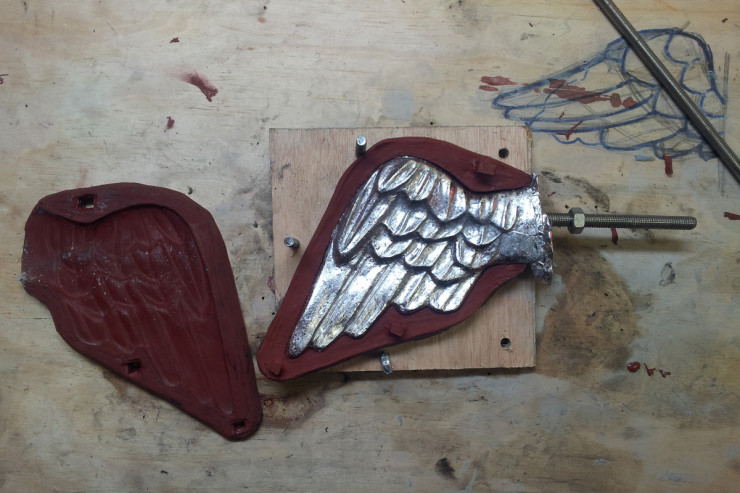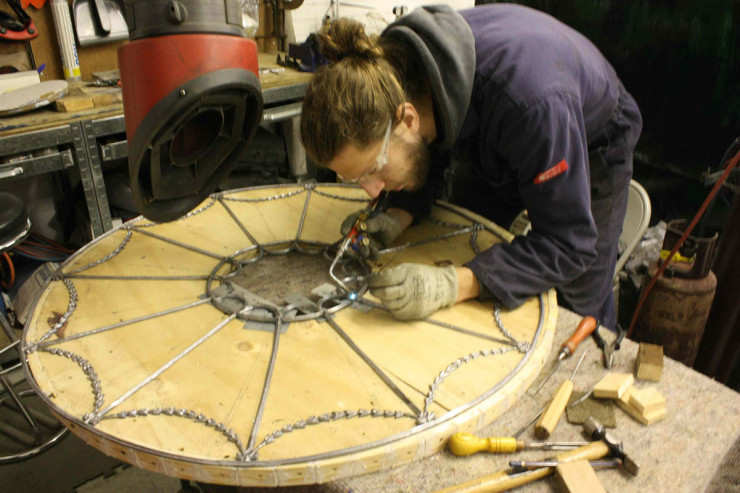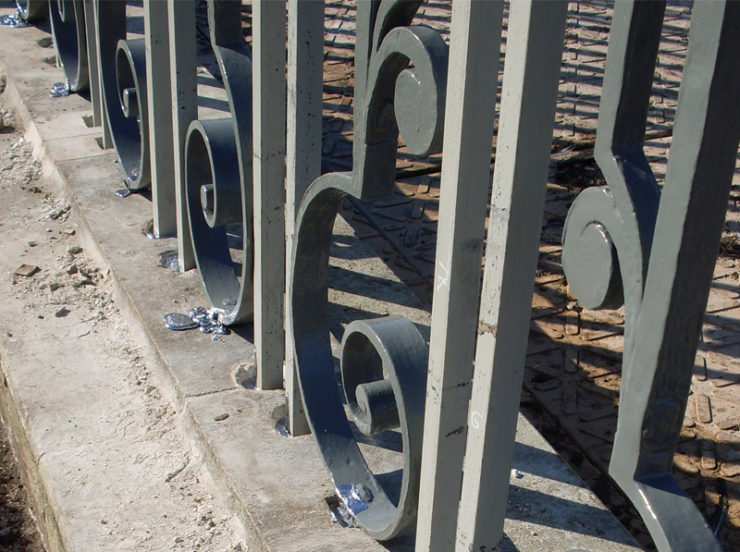Lead
Lead is a very useful and versatile material, in traditional metalwork it is often used for fixings, decorative details and in some coatings. Lead paints for example give an outstanding and durable finish but its removal is a noxious process – something I didn’t take too seriously until recently.
After a year spent working in a mixture of forges and workshops where I occasionally came into contact with lead paint, lead casting and caulking, I was constantly tired and waking up with a metallic taste in my mouth every morning. At the time the possibility of lead poisoning hadn’t occurred to me, I was aware of some of the issues with lead and so I wasn’t being stupid with the material, but I was not being overly careful either. Three months after I stopped working with lead contaminated materials I had a lead blood test and came out with elevated levels, over double the ‘normal’ safe limit – 21μg/100ml. I have recently had a follow up test and my levels have dropped, but if they continue to drop at the same rate, it will take 3.5 years to reach zero.
This article is a cautionary tale about interaction with lead products, it is not written to discourage workshops from using it and it is not a cry for its boycott. It has been written to spread awareness of potential dangers and promote good working practice for the benefit of everyone’s health.
History
The earliest known use of lead is in a figurine found in Egypt dating from 400BC[i] although lead mines have been dated to 6500BC in Turkey.[ii] The Romans mastered the manipulation and production of lead and started using it widely, from water pipes through to cooking pots, occasionally adding lead acetate or “sugar of lead” to their wine for its sweeter flavour. Lead has been used as a decorative material to produce huge sculptures, its corrosion resistant properties mean we still have fine examples of 17th and 18th century sculpture. The corrosion products on old lead protects the clean metal underneath but is highly hazardous to health if ingested.
Lead oxides come in a variety of colours and have been used in paints and pigments, reaching a fashionable height in the 18th century with Ceruse, a white lead makeup used to lighten the skin. The side effects included skin damage, baldness and death. [iii] In more modern times lead has been extensively used as a base for paints and was put into petrol to increase the octane rating.
Working with Lead
Although most people have stopped whitening their faces with Ceruse, craftsmen are unfortunately still exposed to lead more often that they realise, particularly if undertaking conservation or restoration of old ironwork.
The Health and Safety Executive (HSE) lists lead paint burning and stripping as their top risk activity for exposure to lead. [iv] Considering that if anything was painted before 1978 it is likely to be lead paint, it represents a huge risk. Lead putty and fixings have also been used and are commonly found on old ironwork. Lead is also a useful material for casting details or backing repoussé work.
The melting and casting of lead poses a risk. As lead has a low melting temperature ( 327°C ), it is easily melted on a forge or with a gas torch and makes it ideal for quickly pouring and recasting. The problem is that the boiling point of lead ( 1750°C ) is also within the reach of workshop equipment, as lead approaches its boiling point it starts to gives off microscopic vapour much like water approaching its boiling point. However water vapour isn’t going to cause abdominal pain, memory loss or kidney failure, bubbling lead is not a good sign. This can be avoided as working below 650°C should prevent any vapour from forming.
How lead enters the body
The main routes of contamination and lead poisoning come from inhalation and ingestion.
Although lead only minimally passes through the skin, eating, smoking or drinking with lead contaminants on your hands is one of the prime routes lead enters the body; breathing in vapours, airborne lead dust or fumes is the other.
If you have been working with lead containing materials it is likely that dust or other contaminants will have landed on your clothes, and have spread around your workshop laying on all surfaces. If you do not change your work clothes before going home you will be taking lead dust home with you to contaminate your family. If the workshop isn’t cleaned after lead work you will still be picking up lead contamination, ingesting lead dust and taking it home constantly.
Legal requirements
The legal requirements are set out in ‘The Control of Lead at Work Regulations (CLAW) 2002’. This outlines that it is the duty of employers to ‘prevent or adequately control exposure of employees to lead’[v] irrespective of the source of exposure.
This boils down to identify and implement measures to prevent or adequately control exposure, producing risk assessments and record significant findings. It does mean that employers are responsible for issuing protective clothing, promote high standards of personal hygiene and strict housekeeping and provide employees with information, instruction and training.
Symptoms and problems of lead poisoning
The HSE sets the ‘recommended action level’ for blood lead at 35μg/100ml for men and 25μg/100ml for women. At the action level people need to be monitored and removed from the lead working environment until their blood lead level drops. The HSE has been criticised for its approach to lead as it is reported that there is evidence which shows that “as little as 10 to 20 (µg/100ml) can cause chronic, long-term ill health” [vi] it can cause hypertension, stroke, chronic kidney damage, and impaired kidney and brain function, decreased fertility and cancer.
Women (of reproductive capacity) have a reduced allowable level due to the severe effects of lead on children. Much lower levels of lead in children can have severe long term effects and had been linked with decreases in intelligence, short term memory, attention, reading and arithmetic ability, and emotional irregularity.
Methods to avoid poisoning yourself
There are a few simple things you can do to prevent contamination and reduce the likelihood of poisoning yourself and those around you.
When working with lead good practice that we follow in our workshop:
- Bring a separate set of work clothes for the week and change out of going home clothes before starting any operations.
- Wear overalls at all times in the workshop over the work clothes. At the end of the day vacuum your working area before changing out of the overalls and work clothes to avoid taking lead dust home to your family. If possible shower before changing.
- At breaks remove overalls and follow good hygiene practice; wash face and hands before eating, smoking and drinking, biting your nails etc. No food, drink or smoking in the workshop.
- Wear gloves if possible. Not all work can be done in gloves but handling lead painted railings is different to repoussé.
- Vacuum, don’t sweep lead contaminated dust, using a vacuum with suitable filters. Remember all dust in your workshop will be contaminated with lead particles.
- Wear a particle filter mask rather than a dust mask if you have to disturb the dust e.g changing the vacuum bag.
- All heating and burning of lead products should be conducted with extraction or outside and with the correct PPE.
Wearing PPE (personal protective equipment) can and does help.
The main areas of contamination come from work surfaces, clothes and skin. Please be considerate of other people in the working environment, you may be wearing a mask to burn off lead paint but others should also be warned and safe.
References
[i] International Lead Foundation – History of Lead. http://www.ila-lead.org/lead-facts/history-of-lead accessed May 2013
[ii] Toxipedia – Lead. http://toxipedia.org/display/toxipedia/Lead accessed May 2013
[iii] Object Retrieval – Makeup and lead poisoning in the 18th century. http://www.objectretrieval.com/node/111 accessed May 2013
[iv] Health and Safety Executive – Most at risk. http://www.hse.gov.uk/lead/mostatrisk.htm
[v] Control of Lead at Work. Free to download from http://www.hse.gov.uk/lead/
[vi] Hazards org – We told you it was dangerous. http://www.hazards.org/greenjobs/blog/2009/11/16/we-told-you-lead-was-dangerous/




